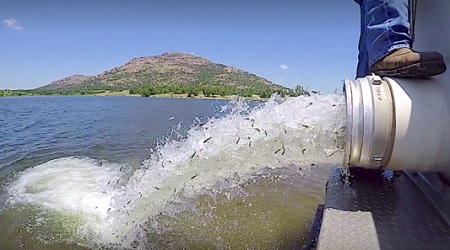 Largemouth bass fishing this spring was notable in Oklahoma, as anglers hauled in several lunkers in the 13- and 14-pound classes. Those monster fish undoubtedly resulted from previous stocking efforts of Florida largemouth bass (FLMB) to increase the trophy potential in Oklahoma’s bass populations, said Cliff Sager, Senior Fisheries Biologist for the Oklahoma Department of Wildlife Conservation.
Largemouth bass fishing this spring was notable in Oklahoma, as anglers hauled in several lunkers in the 13- and 14-pound classes. Those monster fish undoubtedly resulted from previous stocking efforts of Florida largemouth bass (FLMB) to increase the trophy potential in Oklahoma’s bass populations, said Cliff Sager, Senior Fisheries Biologist for the Oklahoma Department of Wildlife Conservation.
The FLMB program is among several fish stocking operations that the Wildlife Department conducts each year, including channel catfish, hybrid striped bass, rainbow and brown trout, walleye, saugeye, striped bass and hybrid sunfish.
The Fisheries Division has stocked more than 15.5 million fry, fingerlings and mature fish into public waters in Oklahoma so far during 2018. Among that total are more than 1.4 million FLMB that have been placed into 39 lakes this year.
Oklahoma’s current state-record largemouth bass was caught in Cedar Lake (Le Flore County) in March 2013 and weighed 14 pounds, 13.7 ounces. “Oklahoma is really right on the line of where you can expect Florida bass to be successful,” Sager said. “Lakes in the southern half of Oklahoma have shown much greater success in sustaining Florida bass genetics.”
All of the Florida bass that the Department stocks are spawned at the Durant fish hatchery. Most of the fish are raised there, but some of the fry are distributed to state hatcheries in Byron and Holdenville for growing into fingerlings. The state’s fourth hatchery at Medicine Park gets involved by helping to deliver FLMB fry and fingerlings to the various lakes for stocking.
“It truly is a coordinated effort to raise and stock that many fish over a short period of time and speaks to the dedication of the Wildlife Department to improve our fisheries resources,” Sager said.
A committee of biologists selects FLMB stocking sites each year based on many criteria. The committee considers the documented success in trophy bass production, as well as angler pressure. Also, lakes with better habitat for bass are more likely to be stocked than lakes where good bass habitat doesn’t exist. Sager said growing trophy bass in a particular lake “is an eight- to 10-year investment.” Therefore, the Wildlife Department concentrates FLMB efforts on the waters that hold the most promise for producing trophy bass.
Since the first of this year, the Wildlife Department has stocked 3,127,834 fingerlings, 12,395,494 fry and 175,027 mature fish of various species into public waters across Oklahoma. Totals for each species are:
- Walleye, 6,302,780.
- Saugeye, 3,099,164.
- Hybrid Striped Bass, 4,318,454.
- Certified Florida Largemouth Bass, 1,418,466.
- Striped Bass, 360,000.
- Rainbow Trout, 133,072.
- Northern Largemouth Bass, 20,246.
- Brown Trout, 7,012.
- Hybrid Sunfish, 3,670.
- Smallmouth Bass, 2,820.
- Threadfin Shad, 2,600.
To see a list of the 39 lakes stocked with FLMB this year, go to https://www.wildlifedepartment.com/fishing/research/surveys and click on “2018 Florida Largemouth Bass Stocking Report.” To see a summary of all stocking efforts, detailing where fish have been stocked this year, go to https://www.wildlifedepartment.com/fishing/research/surveys and click on “2018 Fish Stocking Report.”
The Department’s Florida Largemouth Bass stocking program was the focus of a yearlong series of feature articles in “Outdoor Oklahoma” magazine and for a TV episode of “Outdoor Oklahoma.” Titled “Making Monsters!” this feature series detailed how the Florida bass stocking program works from beginning to end, and explains how this effort is helping to produce state-record trophy bass for the anglers of Oklahoma. To read the series or view the TV show, go to www.wildlifedepartment.com/MakingMonsters. To subscribe to “Outdoor Oklahoma” for only $10 per year, go to www.tinyurl.com/OutdoorOklahoma or call (800) 777-0019.
State release from JK
